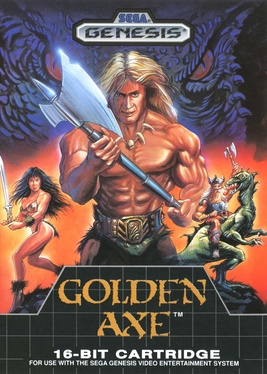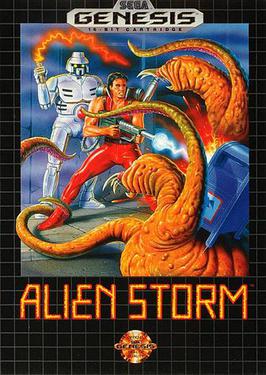
Zero Wing is a 1989 side-scrolling shooter arcade video game developed by Toaplan and originally published in Japan by Namco and in North America by Williams Electronics. Controlling the ZIG space fighter craft, players assume the role of protagonist Trent in a last-ditch effort to overthrow the alien cyborg CATS. It was the eighth shoot 'em up game from Toaplan, and their fourteenth video game overall.

Ghouls 'n Ghosts, known as Dai Makaimura in Japan, is a side-scrolling platform game developed by Capcom, released as an arcade video game in 1988 and ported to home platforms. It is the sequel to Ghosts 'n Goblins and the second game in the Ghosts 'n Goblins series.

Columns is a match-three puzzle video game released by Jay Geertsen in 1989. Designed for the Motorola 68000-based HP 9000 running HP-UX, it was ported to Mac and MS-DOS before being released commercially by Sega who ported it to arcades and then to several Sega consoles. The game was subsequently ported to other home computers, including the Atari ST.

Shinobi (忍) is a side-scrolling hack and slash video game produced by Sega, originally released for arcades on the Sega System 16 board in 1987. The player controls ninja Joe Musashi, to stop the Zeed terrorist organization from kidnapping students of his clan.

After Burner is a rail shooter arcade video game developed and released by Sega in 1987. The player controls an American F-14 Tomcat fighter jet and must clear each of the game's eighteen unique stages by destroying incoming enemies. The plane is equipped with a machine gun and a limited supply of heat-seeking missiles. The game uses a third-person perspective, as in Sega's earlier Space Harrier (1985) and Out Run (1986). It runs on the Sega X Board arcade system which is capable of surface and sprite rotation. It is the fourth Sega game to use a hydraulic "taikan" motion simulator arcade cabinet, one that is more elaborate than their earlier "taikan" simulator games. The cabinet simulates an aircraft cockpit, with flight stick controls, a chair with seatbelt, and hydraulic motion technology that moves, tilts, rolls and rotates the cockpit in sync with the on-screen action.

Altered Beast is a 1988 beat 'em up arcade video game developed and published by Sega. The game is set in Ancient Greece and follows a player character chosen by Zeus to rescue his daughter Athena from the demonic ruler of the underworld, Neff. By collecting three power-ups in a level, the player character transforms into one of five magical beasts. It was ported to several home video game consoles and home computers. Altered Beast was the pack-in game when the Genesis launched in North America and the Mega Drive in Europe.

Space Harrier is a third-person arcade rail shooter game developed by Sega and released in 1985. It was originally conceived as a realistic military-themed game played in the third-person perspective and featuring a player-controlled fighter jet, but technical and memory restrictions resulted in Sega developer Yu Suzuki redesigning it around a jet-propelled human character in a fantasy setting. The arcade game is controlled by an analog flight stick while the deluxe arcade cabinet is a cockpit-style linear actuator motion simulator cabinet that pitches and rolls during play, for which it is referred as a taikan (体感) or "body sensation" arcade game in Japan.

Golden Axe is a 1989 hack and slash game developed and published by Sega for arcades, running on the Sega System 16B arcade hardware. Makoto Uchida was the lead designer of the game, and was also responsible for the creation of the previous year's Altered Beast. The game casts players as one of three warriors who must free the fantastical land of Yuria from the tyrannical rule of Death Adder, who wields the titular Golden Axe.

Super Hang-On is a motorcycle racing arcade video game released by Sega as the sequel to Hang-On. It uses a simulated motorcycle arcade cabinet, like the original game. An updated version was released in arcades 1991 as Limited Edition Hang-On.

Bonanza Bros. is a 3D-style, 2D side-scrolling stealth action game developed and released by Sega in 1990. It is one of the earliest arcade games powered by the Sega System 24 arcade system board. It was ported to various home systems, including the Mega Drive/Genesis, Master System, PC-Engine/TurboGrafx-CD, and several home computers.

Alien Storm (エイリアンストーム) is a beat 'em up shooter released as an arcade video game by Sega in 1990. It was ported to the Genesis/Mega Drive and Master System. The Mega Drive version was re-released on Wii's Virtual Console in 2007 and was also included on Sonic's Ultimate Genesis Collection for Xbox 360 and PlayStation 3. The game was also re-released on the Nintendo Switch Online + Expansion Pack in 2022.

Gain Ground is an action game with strategy elements released as an arcade video game by Sega in 1988. It was ported to the Master System, Mega Drive/Genesis, and TurboGrafx-CD.

Forgotten Worlds, titled Lost Worlds in Japan, is a side-scrolling shooter video game by Capcom, originally released as a coin-operated arcade game in 1988. It is notable for being the first title released by Capcom for their CP System arcade game hardware.

Super Fantasy Zone is a scrolling shooter video game developed and published by Sunsoft for the Mega Drive. Part of Sega's Fantasy Zone series, it was released only in Japan and Europe. Players control the character Opa-Opa on his quest to defeat Dark Menon, and the game plays similarly to previous Fantasy Zone entries. The game plays similarly to Defender, where the screen scrolls in the direction that Opa-Opa is going. The player shoots at enemies to defeat them, collecting gold coins that are used to purchase temporary upgrades that improve Opa-Opa's offensive capabilities and speed, among other things.

Super Thunder Blade (スーパーサンダーブレード) is a combat flight simulation shooter game developed and published by Sega for the Mega Drive/Genesis console. It was one of the two launch titles for the console in Japan, as well as being one of the six launch titles for the console for its U.S. launch. It is a follow-up to the 1987 arcade game Thunder Blade.

Hellfire is a 1989 horizontally scrolling shooter arcade video game originally developed by Toaplan and published in Japan by Taito and North America by U.S.A. Games. The first horizontal shoot 'em up title to be created by Toaplan, the game takes place in the year 2998 where a space matter known as Black Nebula created by robot dictator Super Mech spreads and threatens to engulf human-controlled galaxies, as players assume the role of Space Federation member Captain Lancer taking control of the CNCS1 space fighter craft in a surprise attack to overthrow the enemies with the fighter craft's titular weapon.

Wardner is a side-scrolling platform game developed by Toaplan and published in arcades worldwide by Taito in 1987.

Devil's Crush is a pinball video game developed by Compile for the TurboGrafx-16 and released in 1990. The second installment in the Crush Pinball series after Alien Crush, the game has an eerie occult theme with skulls, skeletons, and demons. It was later followed by Jaki Crush and Alien Crush Returns.

Fantasy Zone II: The Tears of Opa-Opa is a horizontally scrolling shooter for the Master System published by Sega in 1987. It was ported to the arcade, Famicom, and MSX2, and was remade for the System 16 hardware on a PlayStation 2 compilation in 2008. It was re-released on the Wii Virtual Console in North America on June 29, 2009. Like the first Fantasy Zone, the player controls a sentient spaceship named Opa-opa who fights surreal invader enemies. Like its predecessor, Fantasy Zone II departs from scrolling shooter themes with its bright colors and whimsical designs. For this reason, it is occasionally dubbed a "cute 'em up".

M2 Co., Ltd. is a Japanese video game developer and publisher, best known for handling emulation of re-released games, such as some Sega Ages titles, Virtual Console titles for Nintendo systems, the 3D Classics series for the Nintendo 3DS and their ShotTriggers range of classic STG games. M2 has also created entirely new titles such as WiiWare games for Konami under the ReBirth moniker and more recently a new GG Aleste game. In addition, M2 currently holds the rights of Aleste series and all NEC Avenue and NEC Interchannel games on TurboGrafx-16 and variants, previously owned by Lightweight.






















